I have been, or can be if you click on a link and make a purchase, compensated via a cash payment, gift, or something else of value for writing this post. As an Amazon Associate, I earn from qualifying purchases. Please read my full Affiliate Disclosure for more information.
Breeze block walls are making a stylish comeback, and it’s easy to see why! Their unique geometric patterns and versatile appeal make them a popular choice for adding both privacy and aesthetic charm to any space.
In this article, you’ll uncover a variety of creative breeze block wall ideas that can transform your home or garden. From contemporary accents to vintage-inspired designs, these ideas will inspire you to experiment and elevate your decor with this timeless yet trendy material.
1. Modern Monochrome Breeze Block Wall for Minimalist Spaces
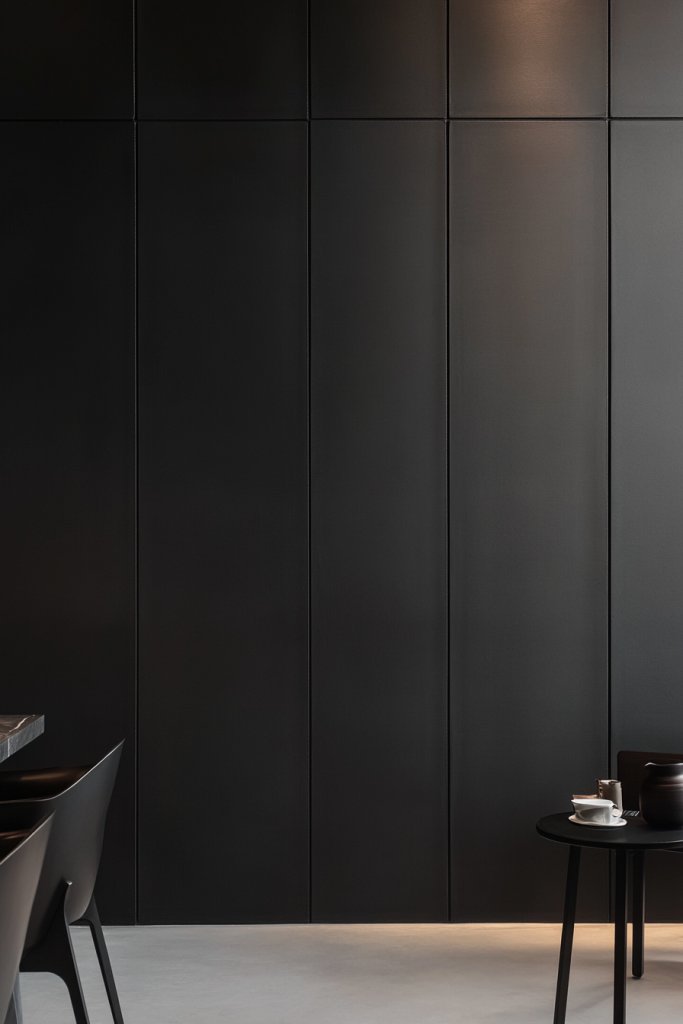
Ever feel overwhelmed by clutter and busy decor? A minimalist space with clean lines can bring calm and clarity. Sometimes, reducing visual noise is the best way to refresh your mindset. A sleek, monochrome breeze block wall might just be the upgrade your home needs to feel more spacious and Zen.
Imagine a crisp, all-white breeze block wall stretching across your living area, creating a subtle yet striking partition. The uniform color enhances the geometric pattern, casting delicate shadows as sunlight filters through. The smooth, matte finish contrasts with textured furniture, adding depth without chaos. It’s like turning your wall into a canvas of simplicity that amplifies light and space.
You can switch the monochrome theme from pure white to shades of gray or black for different moods. For a more dramatic look, pair the breeze blocks with dark accents or polished concrete floors. Alternatively, keep it light and airy for a Scandinavian vibe, or add soft textiles for a cozy touch in colder seasons. This concept adapts easily to small apartments or open-plan homes.
Start by choosing high-quality breeze blocks with a smooth surface. Prepare your wall surface, ensuring it’s level and clean. Apply a uniform coat of primer if painting, then use painter’s tape for sharp edges. For installation, secure the breeze blocks with mortar or adhesive suited for your wall type. Finish with a matte or satin paint for a seamless monochrome effect. Regular cleaning keeps the finish pristine.
Add subtle texture by incorporating textured or patterned breeze blocks, or paint just some sections in a contrasting shade. Use sleek metal or wood trims to frame the wall for a polished look. You can also embed LED strips behind the blocks for a soft glow at night. Personal touches like a soft throw, plush cushions, or minimalist artwork can elevate the space further.
A monochrome breeze block wall is a timeless addition that elevates any modern space. It’s simple enough for beginners yet impactful enough to impress guests. This idea proves that minimalism can be bold and beautiful. Ready to make your space feel more expansive and stylish? Go monochrome and enjoy the sleek transformation!
2. Color-Tinted Breeze Blocks for a Bold Accent Wall
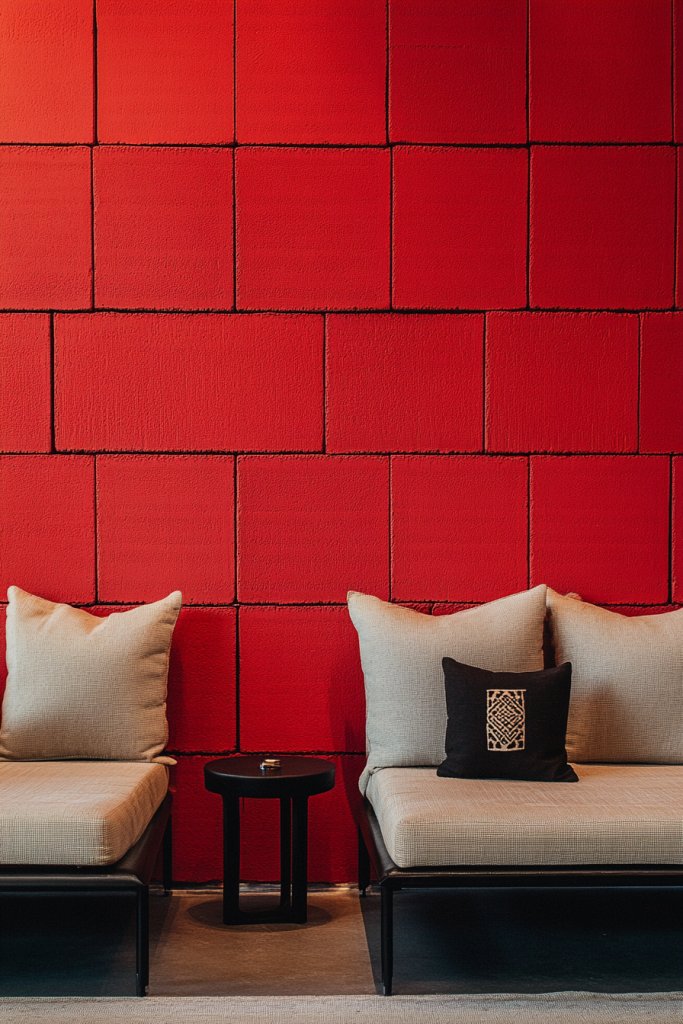
Tired of boring walls that do nothing for your room’s personality? Adding a splash of color can instantly energize your space. But painting a whole wall can sometimes feel overwhelming or too permanent. What if you could customize your breeze blocks with vibrant or pastel hues for a striking, yet flexible feature?
Picture breeze blocks painted in lively turquoise, blush pink, or bold navy, forming a mosaic of colors that catch the eye. When sunlight hits, the colors seem to pop and shimmer, creating a lively backdrop. The textured surface of the breeze blocks enhances the hues, making them feel tactile and inviting. It’s like turning a plain wall into a piece of art that changes with the light.
Choose colors based on your mood or seasonal themes—bright for summer, muted for fall. You could opt for a gradient effect, blending two or three shades for a subtle transition. For a more eclectic vibe, alternate colors in a pattern or randomly for a playful look. This approach works well in kitchens, playrooms, or even outdoor patios.
Select weatherproof or high-quality masonry paint suitable for your breeze blocks. Clean and prime the surface to ensure even coverage. Use painter’s tape to create clean lines if doing a pattern, or paint freehand for a more organic look. Apply multiple thin coats, allowing drying time in between. For outdoors, seal the paint with a clear topcoat for durability. Touch up as needed to keep colors vibrant.
Incorporate color-blocked sections or geometric shapes to give it a modern twist. Combine with neutral furniture to let the colors stand out. Use contrasting grout or border trims to frame the painted blocks. Consider adding decorative decals or stencils to further personalize the pattern without overcomplicating the look.
Color-tinted breeze blocks turn a simple wall into a statement piece that reflects your personality. They’re easy to update or change if your style evolves—just repaint or add new patterns. It’s a fun way to experiment with color without committing to a full wall of paint. So, why not add a bold splash of your favorite hue and brighten up your space today?
3. Patterned Breeze Block Walls with Geometric Designs
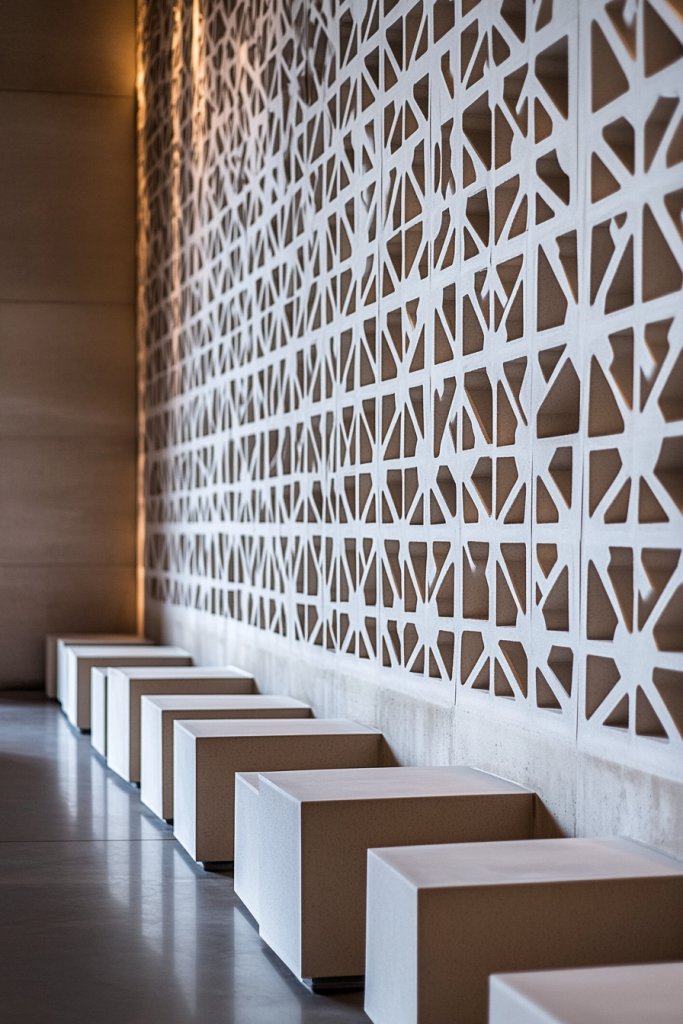
Looking to add visual interest to a plain wall? Geometric patterns can bring a modern, eye-catching element to any space. But creating intricate designs with tiles or wallpaper can be costly or tricky. Breeze blocks offer a versatile, low-maintenance alternative that can showcase bold patterns.
Imagine a wall where breeze blocks are arranged in a repeating diamond or chevron pattern. The open spaces create a lattice that casts interesting shadows, especially when illuminated from the side. The pattern adds rhythm and movement, making the wall a focal point. Textured or painted in contrasting shades, the geometric design becomes a dynamic piece of decor.
Mix and match different shapes—triangles, diamonds, hexagons—for a custom look. Use monochrome shades for a subtle pattern or vibrant colors for maximum impact. You can also vary the size of the breeze blocks for a playful, layered effect. This approach suits both indoor feature walls and outdoor garden partitions.
Plan your pattern and mark the layout on the wall with chalk or painter’s tape. Choose breeze blocks with consistent dimensions for precision. Use adhesive or mortar to secure them in the desired pattern. For painted designs, mask off sections with painter’s tape and apply contrasting colors. Seal or treat outdoor patterns to withstand weather changes. Regularly check alignment during installation for a crisp finish.
Add metallic or painted accents within the pattern to create a layered look. Incorporate lighting fixtures like spotlights to enhance shadows and textures. Frame the pattern with sleek trims or molding for a polished edge. Personalize further by embedding small decorative elements in some breeze block openings, like metal accents or textured panels.
Patterned breeze block walls bring a contemporary edge that elevates your decor effortlessly. They’re highly customizable, so you can tailor the design to your style or space constraints. It’s a clever way to add style without overwhelming your budget or DIY skills. Ready to turn your wall into a geometric masterpiece?
4. Vertical Garden Integration with Breeze Blocks
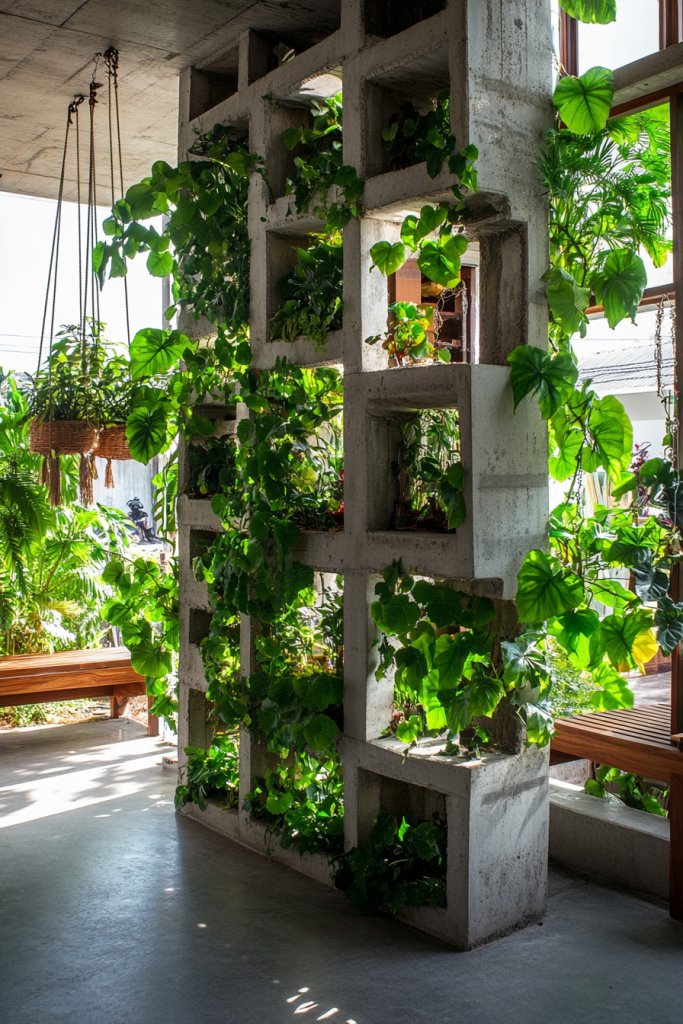
Dreaming of a lush garden but lacking outdoor space? Vertical gardens are the perfect solution to bring greenery into tight spots. But installing traditional planters can look cluttered and require constant maintenance. Breeze blocks provide a stylish, functional way to blend architecture with nature.
Visualize a wall of breeze blocks with integrated planters filled with trailing vines or succulents. The openwork design allows sunlight to reach plants, creating a living, breathing wall. As plants grow, they soften the hard architecture, adding texture and color. The combination of concrete and greenery offers a vibrant, natural contrast that is both calming and modern.
Use built-in planters of different sizes and shapes to add variety. Incorporate moss panels or small herb gardens for practicality. For outdoor patios, choose weather-resistant plants and containers. Indoors, select low-maintenance greenery suited for low light. Change plants seasonally or as your tastes evolve to keep the wall fresh.
Select breeze blocks with built-in niches or create custom planter inserts. Secure them to your wall using appropriate mortar or fasteners. Fill the compartments with soil, then plant your chosen greenery. Ensure proper drainage and watering systems are in place. Regular pruning and watering keep the garden vibrant and healthy. Consider installing a drip irrigation system for ease.
Add decorative stones or colorful mulch in planters for visual interest. Use different plant textures and heights for a layered effect. Incorporate lighting like small spotlights or LED strips to highlight the greenery at night. Personalize with custom plant labels or decorative stakes that match your decor style.
Integrating greenery into your breeze block wall creates a fresh, lively atmosphere that enhances any space. It’s a sustainable, eco-friendly upgrade that also improves air quality. Whether indoors or outdoors, this idea proves you don’t need a garden to enjoy nature’s beauty. Start small and watch your green wall flourish!
5. Textured Finish for a Rustic or Industrial Look
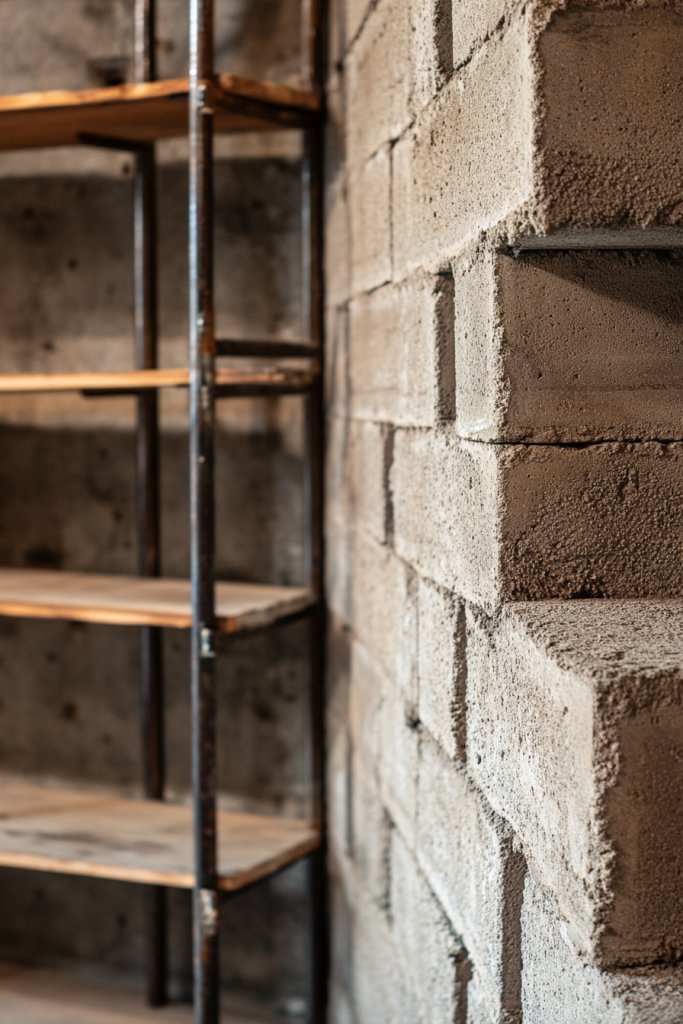
Craving a space that feels raw and authentic? Rustic and industrial styles emphasize natural materials and imperfect finishes. Flat, smooth walls can sometimes feel sterile or boring. Adding texture to breeze blocks can transform your space into a rugged, inviting environment.
Imagine a breeze block wall with a rough, uneven surface, showcasing the natural grain of concrete or stone. The textured finish creates shadows that shift with the light, adding depth and character. Pair it with reclaimed wood furniture and vintage metal fixtures for a cohesive industrial vibe. This tactile surface invites touch and curiosity.
Use different techniques—such as applying textured plaster, concrete overlays, or leaving the breeze blocks in a raw state. For a rustic look, incorporate visible aggregate or chipped edges. For a cleaner industrial style, opt for a polished but textured concrete finish. The texture can be subtle or pronounced depending on your preference and space.
Start by prepping the breeze blocks with a base coat of primer. Apply textured finishes using tools like trowels, sponges, or brushes to create varied effects. For a natural look, leave some areas rough and others smoother. Seal the surface with a matte or satin topcoat to protect against dust and damage. For outdoor applications, select weatherproof textures and sealants. Regular maintenance involves gentle cleaning to preserve the texture.
Incorporate metallic accents, such as rusted steel or bronze fixtures, to amplify the industrial feel. Use warm lighting to highlight the texture’s shadows. Add vintage or distressed furniture to complement the rugged finish. You can also embed small decorative elements like metal hooks or bolts for an authentic touch.
A textured breeze block wall offers a distinctive, handcrafted aesthetic that stands out. It’s an excellent way to add depth and personality without overwhelming your space. This style works well in lofts, studios, or any area craving a bit of edge. Embrace the beauty of imperfection and give your walls a new level of character.
6. Lighted Breeze Block Wall for Ambient Illumination
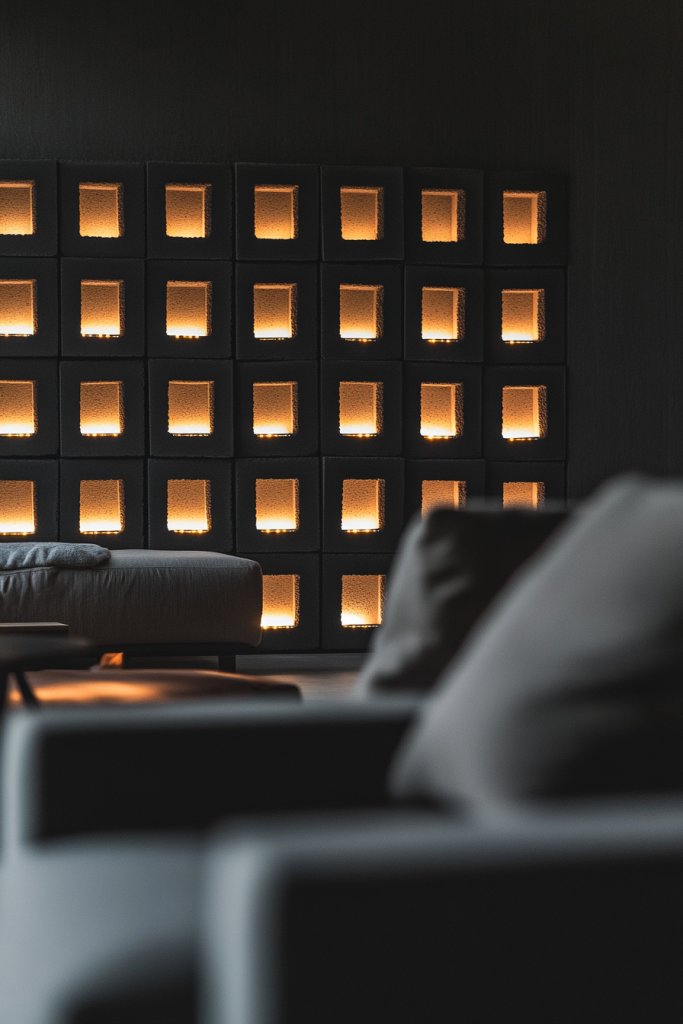
Ever wish your space could glow with a cozy, inviting ambiance? Good lighting transforms a room from ordinary to extraordinary. But harsh overhead fixtures can feel clinical. Installing soft, indirect lighting behind breeze blocks creates a warm, ambient glow that enhances your decor and mood.
Picture a breeze block wall with hidden LED strips installed along the top or behind individual blocks. As the light filters through the openings, it casts decorative shadows across the room. The glow is gentle yet sufficient to set a relaxing tone. During evenings, this subtle illumination transforms your space into a cozy retreat, perfect for unwinding or entertaining.
Choose warm white or colored LED lights to match your theme. For a more dramatic effect, synchronize lighting with music or set dimming levels. Install lighting in outdoor walls for magical garden evenings. Incorporate dimmable fixtures for flexibility, and consider using smart lighting controls for convenience. This concept suits both modern and industrial aesthetics.
Determine the desired lighting placement—inside the breeze blocks or mounted behind. Use LED strip lights with adhesive backing for easy installation. Conceal wiring behind the wall or along the edges for a clean look. Secure the strips with clips or mounting channels. Connect to a power source, and configure your dimming or color options. Test the lighting thoroughly before finishing to ensure even illumination. Regular maintenance involves checking connections and replacing batteries or strips as needed.
Sync your lighting with smart home systems for remote control and scheduling. Add decorative fixtures like small sconces or candle-like LEDs for a cozy vibe. Layer lighting with other sources like floor lamps or fairy lights to create depth. Personal touches like color-changing options can match your mood or season.
Lighting transforms your breeze block wall into a functional art piece that elevates your entire space. It’s an effortless way to add warmth and personality, especially in low-light settings. Embrace soft, indirect lighting to make your home feel more inviting and stylish. Ready to light up your walls and mood?
7. Creating Partial Wall Divisions with Breeze Blocks
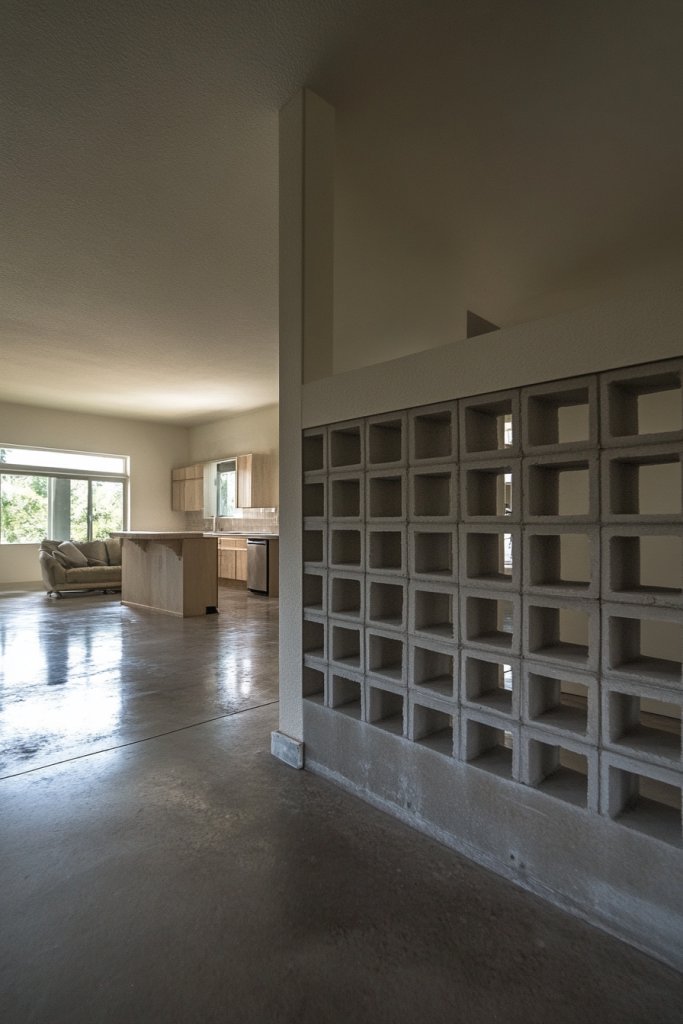
Need to define spaces without sacrificing openness? Fully enclosed walls can make a room feel cramped. Partial divisions using breeze blocks create a sense of separation while maintaining airflow and light. It’s the perfect balance between privacy and connection.
Imagine a half-height breeze block wall dividing a living room from a dining area. The open pattern allows sunlight and chatter to flow through, while still creating distinct zones. The textured pattern adds visual interest and a modern touch. As you move around, the partial wall subtly guides your eye and space, making it feel larger and more functional.
Adjust the height and density of the breeze block partition depending on your needs. For a softer look, paint or finish the breeze blocks in neutral tones. For a bold statement, go for contrasting colors or metals. You can also add a built-in shelf or bench on top for extra utility. This idea works in open-plan living rooms, studios, and outdoor patios.
Measure and mark the desired height and position of your partial wall. Use a level and chalk to ensure precision. Secure breeze blocks with mortar or wall anchors, depending on your wall type. Consider reinforcing the structure with a supporting frame if necessary. Finish with paint or sealant to match your decor. Remember to leave gaps or openings for airflow and aesthetic balance.
Decorate the top of the partial wall with decorative tiles or wood trim for a polished look. Incorporate functional elements like hooks or small shelves for storage. Use contrasting colors or patterns to create visual interest. Personalization can also include embedding lighting or artwork in the open sections.
Partial breeze block walls are a stylish, practical solution that enhances your space’s flow. They require minimal structural work but deliver maximum visual and functional impact. Perfect for creating privacy zones without sacrificing openness. Why not experiment with different heights and patterns to customize your space?
8. Using Breeze Blocks as a Backdrop for Shelving
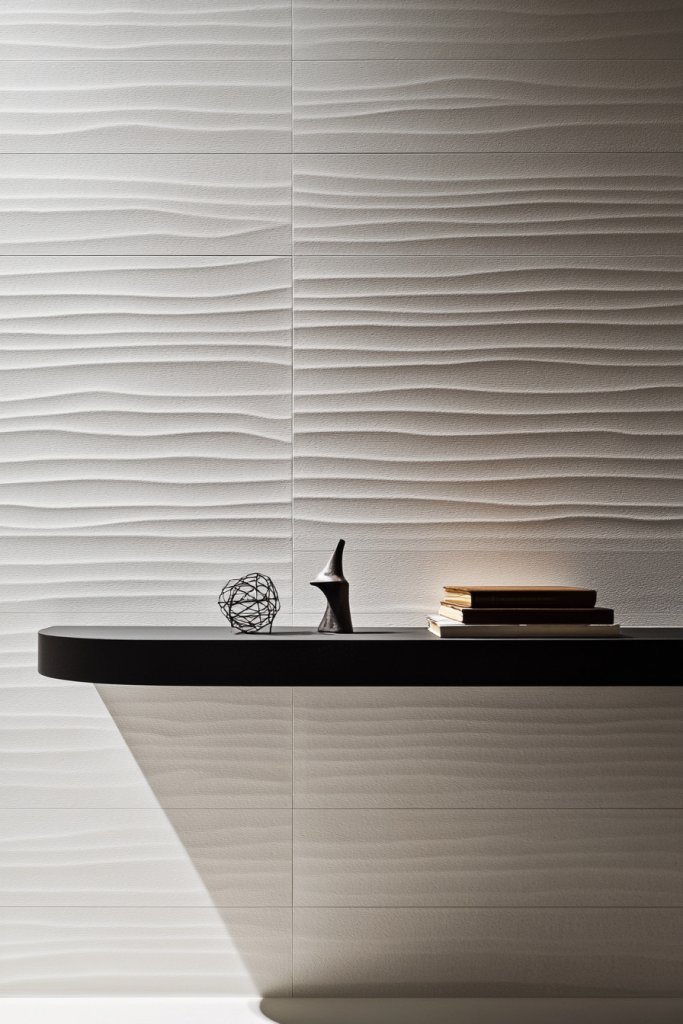
Looking for a unique way to display your favorite items? A plain wall can feel dull, but integrating shelving into a breeze block backdrop adds both function and style. It’s a clever way to showcase books, plants, or decorative objects without cluttering the space.
Visualize floating shelves mounted directly onto a breeze block wall, with open spaces between the blocks creating natural dividers. The textured surface adds depth, making the shelf displays pop. When illuminated with spotlights or ambient lighting, the arrangement becomes a gallery of your favorite things, blending architecture with decor.
Use sleek, minimalist shelves for a modern look or rustic wood for a cozy vibe. Install different lengths and heights to add visual interest. For a playful touch, incorporate colorful or patterned brackets. This setup suits living rooms, kitchens, or even outdoor patios where display space is limited.
Mount the shelves using appropriate anchors and brackets suited for your wall and weight load. Ensure the breeze blocks are securely attached and level. Consider adding LED strip lighting underneath shelves for an eye-catching effect. Keep the objects balanced and avoid overcrowding. Regularly check the stability and clean the surface for dust and dirt.
Customize shelves with painted or stained finishes to match your decor. Mix different styles and sizes for an eclectic look. Incorporate decorative boxes or baskets for storage. Add small accent lights or decorative hardware to elevate the display.
Using breeze blocks as a backdrop for shelving combines practicality with aesthetics. It’s a smart, space-saving idea that also personalizes your home. With a little planning, you can turn a simple wall into a functional art installation. Ready to display your treasures in style?
9. Incorporating Mirrors into Breeze Block Walls
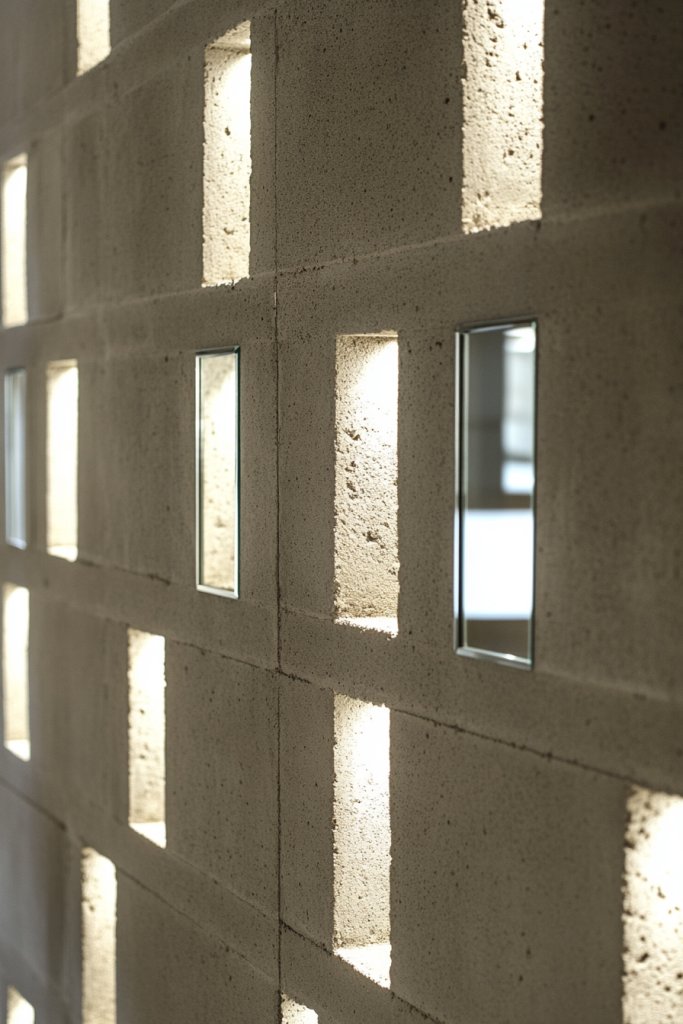
Want to make your space feel larger and brighter? Mirrors are a classic trick that can do just that. But instead of a plain mirror, imagine integrating mirrors into a breeze block wall for a modern, architectural touch. It’s an innovative way to reflect light and expand your room visually.
Picture a wall where some breeze blocks are replaced with or embedded with mirror panels. The reflective surfaces bounce natural and artificial light around, making the room feel more open. The geometric pattern of the breeze blocks combined with sleek mirrors creates a chic, contemporary aesthetic. Shadows and reflections add depth, making the wall a focal point.
Use frameless or decorative-framed mirrors depending on your style. Mix mirrored breeze blocks with painted ones for contrast. For outdoor or bathroom applications, opt for weatherproof or frosted mirrors. Incorporate different shapes—round, square, or irregular—for a dynamic look. This works well in hallways, bedrooms, or even as a privacy screen.
Choose mirror panels that fit within the breeze block openings or cut custom sizes. Secure them with waterproof or strong adhesive suited for glass. Ensure the mirrors are level and clean before installation. Use safety glass if in high-traffic areas or outdoors. Seal edges to prevent moisture ingress. Regularly clean the mirrors with suitable glass cleaner to maintain clarity.
Frame some mirrors with decorative trims or LED backlighting for extra flair. Create a pattern with alternating painted breeze blocks and mirrored ones for visual rhythm. Use small decorative elements like metallic accents or textured surrounds nearby. Personal touches like etched designs or frosted finishes can add privacy or artistic appeal.
Incorporating mirrors into breeze block walls is a clever way to enhance light and perception of space. It’s a modern upgrade that adds sophistication and function. With minimal effort, you can dramatically transform your rooms into airy, luminous environments. Embrace this innovative approach and reflect your style!
10. Combining Breeze Blocks with Wood Panels for Warmth
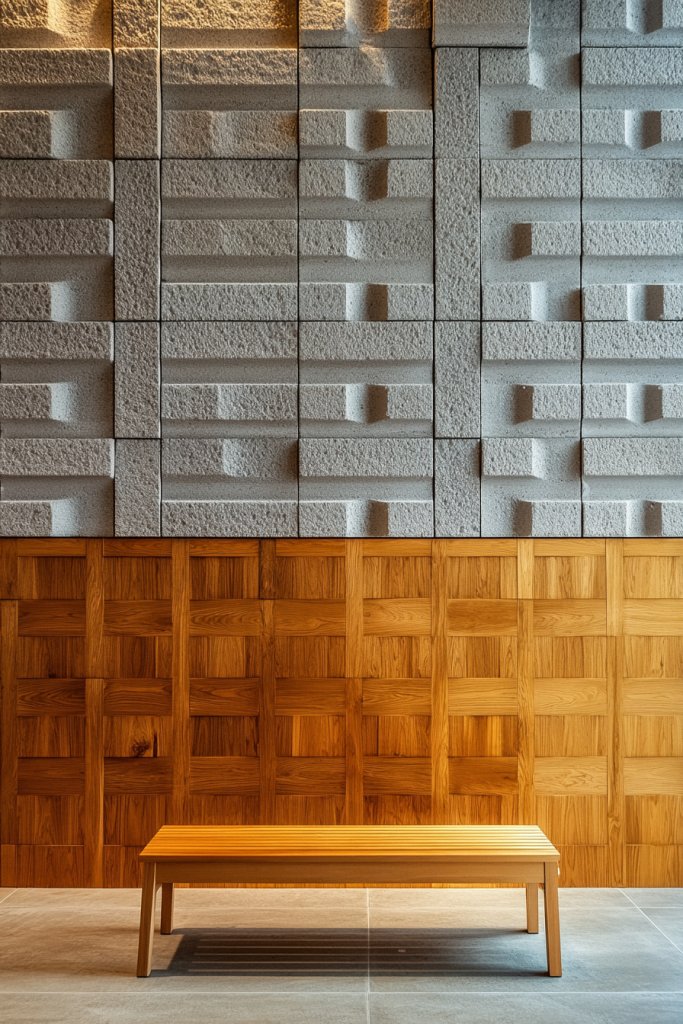
Feeling that your space lacks warmth and coziness? Industrial and concrete finishes can sometimes feel cold and uninviting. But mixing breeze blocks with wood panels creates a balanced, welcoming aesthetic. It’s an easy way to add texture, warmth, and character to your decor.
Imagine a wall where the lower half features reclaimed wood panels, while the upper section showcases a pattern of breeze blocks. The contrast between the warm, organic wood grain and the cool, geometric breeze blocks creates visual harmony. When lit softly, the combination exudes both rustic charm and modern elegance. The layered textures invite touch and add depth to the space.
Choose wood finishes ranging from natural and rough-hewn to smooth and stained. Use lighter woods for a Scandinavian feel or darker tones for a richer look. Combine with painted breeze blocks for a bold statement or keep both elements natural for a subtle blend. This style adapts well in living rooms, kitchens, or outdoor features.
Install wood panels with wall anchors or adhesive, ensuring they are level and securely attached. Attach breeze blocks with mortar or suitable fasteners, aligning them to create a seamless pattern. Finish with protective sealants on wood to withstand moisture. For outdoor applications, opt for weather-resistant wood and sealants. Balance the materials visually, and consider leaving some gaps for airflow.
Customize the wood with stains, paints, or carvings to suit your style. Add soft textiles like cushions or throws nearby for comfort. Use lighting to highlight the textures—warm LED strips or spotlights work well. Personalize with decorative hardware or metal accents that complement the wood’s warmth.
Combining breeze blocks with wood panels creates a space that feels both modern and inviting. It’s a versatile look that works in urban lofts, rustic cabins, or contemporary homes. The mix of textures adds personality and depth, making your walls a true focal point. Embrace this blend for a cozy yet stylish home transformation.
11. Installing a Breeze Block Partition with Built-in Seating
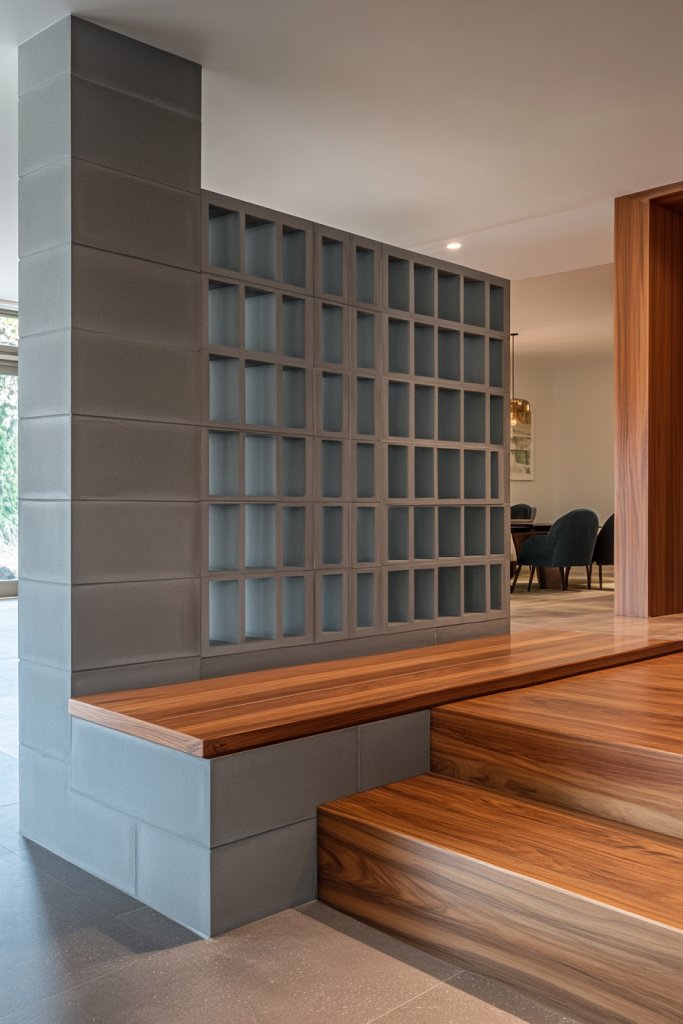
Ever wish your home had more functional space without sacrificing style? A breeze block partition can divide areas while adding a stylish element. Imagine turning part of that partition into a built-in bench or seating nook—functional, space-saving, and chic.
Picture a half-height breeze block wall running along a hallway or outdoor patio, with a cushioned seat built into the lower section. The open pattern allows airflow and visual connection while providing a cozy spot to sit. The textured breeze blocks combined with a soft cushion create a casual, inviting vibe that encourages lingering. It transforms a simple divider into a multi-purpose feature.
Use different materials for the seat cushion—fabric, leather, or outdoor-ready textiles—to match your decor. Add decorative pillows for comfort and style. This concept adapts to outdoor patios, entryways, or even as a room divider. You can also extend it into a full-height wall with integrated storage or shelving.
Construct the breeze block partition with sturdy mortar or fasteners. Build a reinforced seat base using weatherproof materials if outdoors. Attach the cushions securely with slipcovers or mounting brackets. Ensure the structure is stable and level, especially if it’s a seating area. Finish with weatherproof sealants for outdoor use or paint for indoor settings. Incorporate drainage or ventilation if needed.
Decorate the seat with colorful cushions, throws, or textured fabrics. Add small side tables or planters nearby to enhance usability. Personalize the area with decorative trim or framing around the top edge. Create a relaxed atmosphere with ambient lighting or string lights if outdoors.
This functional twist on breeze block partitions adds character and utility to your home. It’s perfect for small spaces where every inch counts. With a little DIY effort, you can craft a stylish seating nook that’s both practical and attractive. Ready to turn your walls into multifunctional masterpieces?
12. Creating a Privacy Screen in Outdoor Patios
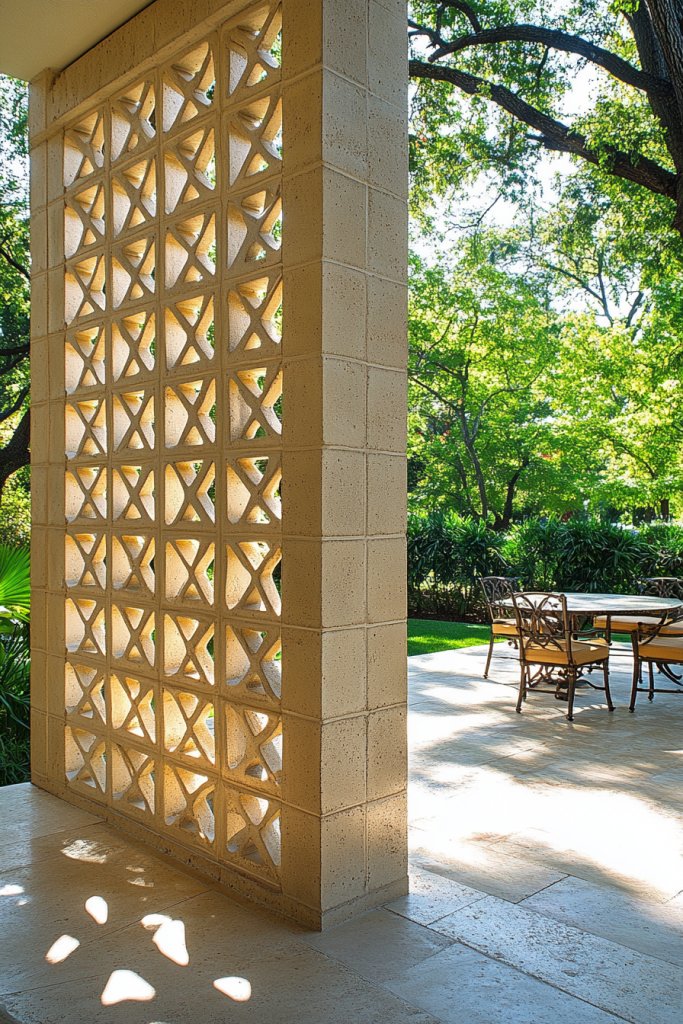
Seeking privacy in your outdoor oasis? Fences and hedges are common, but they can feel bulky or unnatural. Breeze blocks offer a stylish alternative that combines openness with seclusion. They let in air and light while shielding you from prying eyes, perfect for patios or garden corners.
Visualize a low breeze block wall with intricate patterns or openwork sections, shielding your seating area from neighbors. The textured pattern casts dynamic shadows, creating a sense of enclosure without feeling closed-off. When surrounded by lush plants or flowers, it blends natural beauty with architectural interest. The result is a cozy, private retreat that feels both modern and inviting.
Vary the height and pattern density of your breeze block screen for different levels of privacy. For more openness, opt for larger openings; for more seclusion, choose tighter patterns. Use weatherproof finishes and durable materials for outdoor durability. Enhance the aesthetic with decorative caps, trims, or integrated lighting. It’s adaptable to small balconies, large patios, or garden pathways.
Build a sturdy base using concrete or treated wood posts anchored securely into the ground. Attach breeze blocks with outdoor mortar or fasteners designed for exterior use. Leave gaps for airflow and access if needed. Seal all joints and surfaces to withstand weather. Install lighting or decorative elements to enhance the privacy screen at night. Regular maintenance involves cleaning and checking stability.
Add decorative caps, metal accents, or paint details to match your outdoor decor. Plant climbing vines or flowers along the base to soften the structure further. Incorporate solar-powered or LED lighting for evening ambiance. Personalize with engraved or painted motifs that reflect your style.
A breeze block privacy screen elevates your outdoor space with style and function. It provides seclusion without sacrificing airflow or light, making your patio a true sanctuary. With minimal effort, you can craft a customized, durable barrier that complements your landscape. Why not create your own outdoor haven today?
13. Using Colored Grout to Highlight Breeze Block Patterns
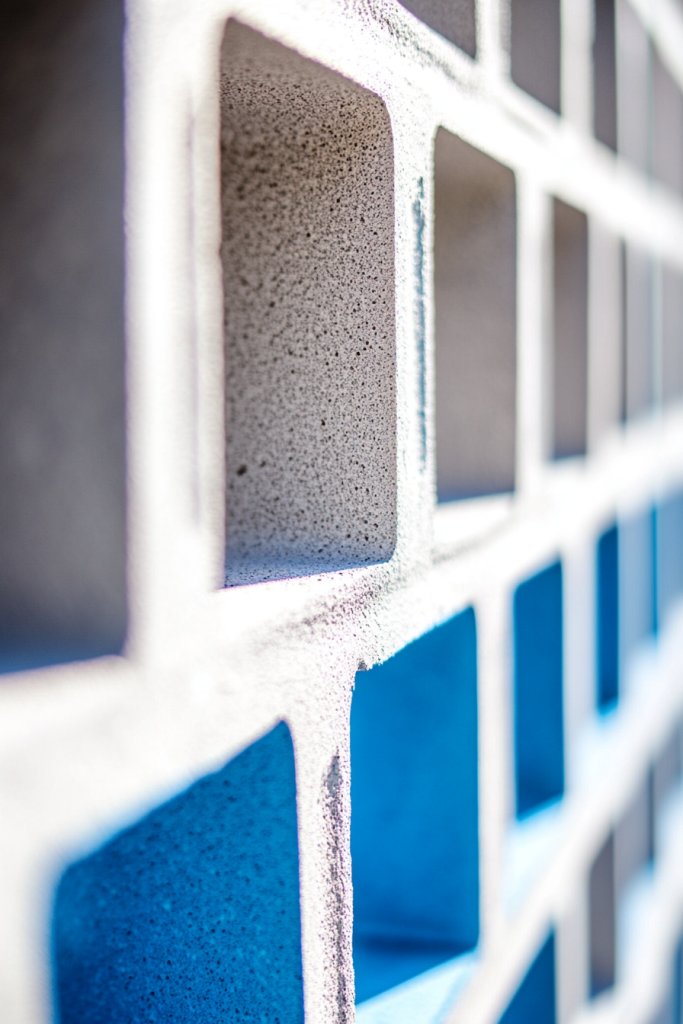
Want to add a subtle pop of color or emphasize your pattern? Grout color can dramatically change the look of breeze blocks. Instead of traditional neutral grout, using contrasting or bold hues makes the pattern stand out. It’s a simple tweak with a big visual impact.
Imagine a wall where the breeze blocks are unified by a dark grout, making the pattern pop against a light background. Alternatively, bright-colored grout like turquoise or orange adds playful energy. The grout lines become a design feature, framing each block and drawing attention to their arrangement. The textured surface of the breeze blocks combined with vivid grout creates an artistic, eye-catching display.
Choose grout colors that complement or contrast with your wall paint or decor. For more subtle accents, select shades close to the breeze blocks’ color. For a bold statement, pick high-contrast hues. Use special epoxy or staining techniques for permanence and weather resistance outdoors. This approach suits feature walls, outdoor fences, or accent partitions.
Apply painter’s tape around the breeze blocks to keep grout lines sharp. Use a rubber float to press grout into the joints, ensuring full coverage. Wipe excess grout with a damp sponge before it dries, and clean the surface carefully. For outdoor applications, seal the grout with a weatherproof sealer to prevent staining or discoloration. Regular touch-ups keep the pattern crisp and vibrant.
Combine different grout colors to create patterns or borders. Incorporate metallic or iridescent grout for a modern twist. Use grout coloring techniques like staining or tinting to customize shades further. Personalize the effect by adding small decorative tiles or mosaics within some breeze block openings.
Colored grout transforms a standard breeze block wall into a vibrant feature that reflects your personality. It’s an affordable way to add depth and interest without changing the structure. Experiment with different colors and patterns to find your signature look. Ready to make your wall truly unique?
14. Framing Breeze Blocks with Metal or Wooden Borders
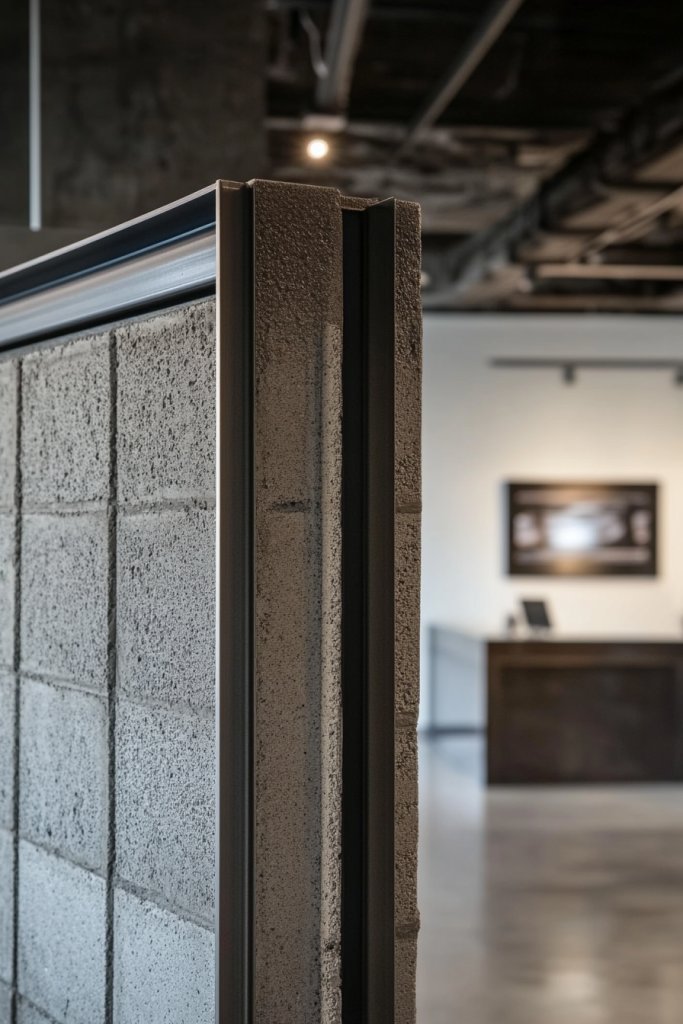
Want a more refined, gallery-style look for your breeze block wall? Framing the edges with metal or wood elevates the design. It creates a clean, finished appearance that transitions smoothly into adjacent walls or furnishings. Plus, it helps define the pattern and adds a touch of sophistication.
Visualize a breeze block wall with sleek metal strips or warm wooden trims outlining each section. The framing highlights the geometric pattern and adds a subtle contrast in textures. When paired with minimalist decor, it gives a contemporary, curated vibe. The combination of materials enhances depth and visual interest, making the wall a true centerpiece.
Choose metal finishes like matte black, brushed steel, or copper for a modern look. For a warmer feel, opt for natural or stained wood trims. Use slim profiles for a subtle frame or thicker borders for a more pronounced effect. This approach suits both indoor feature walls and outdoor garden partitions that require a polished finish.
Attach metal strips or wooden trims securely along the edges of your breeze block pattern using appropriate fasteners or adhesive. Ensure all corners and joints are aligned and flush for a seamless appearance. Seal or treat the wood to prevent weather damage if outdoors. For metal frames, consider powder coating or painting for durability. Finish by cleaning the surfaces and touch-up painting if necessary.
Decorate the borders with metallic paint or staining to match your decor palette. Add small decorative hardware, like rivets or metal studs, for extra detail. Use lighting—spotlights or LED strips—along the borders to accentuate the framing at night. Personal touches like engraved initials or patterns can make the framing uniquely yours.
Framing breeze blocks with metal or wood makes your wall look professionally finished and stylish. It’s a simple upgrade that adds value and visual clarity. This approach works in modern, rustic, or industrial spaces alike. Why not frame your pattern and give your walls a crisp, artistic edge?
15. Breeze Blocks as a Headboard in Bedroom Spaces
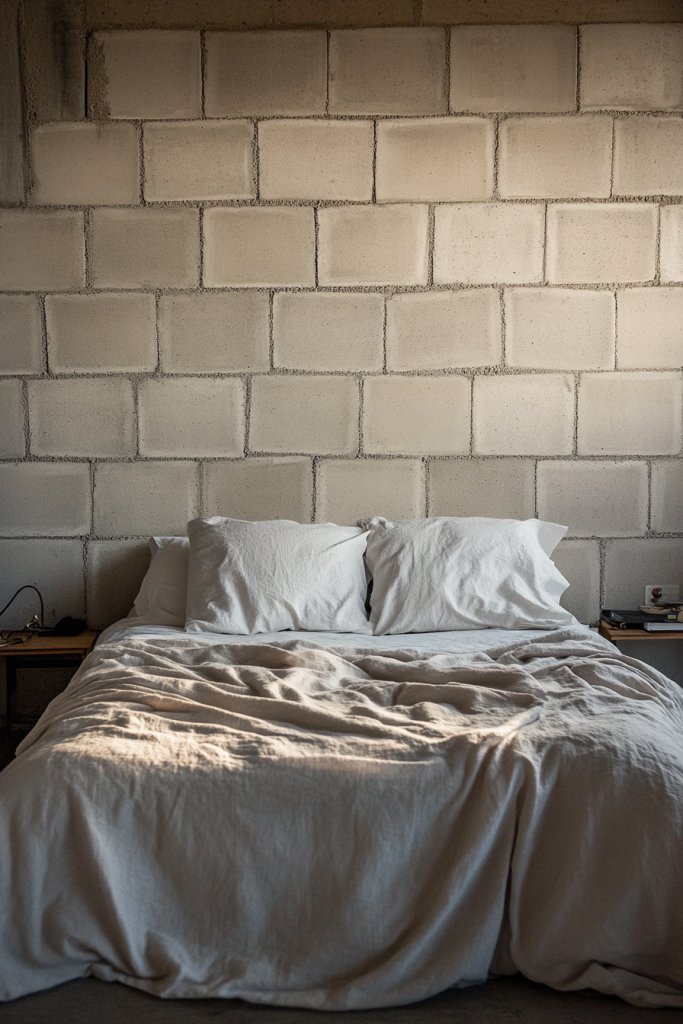
Looking to add texture and privacy behind your bed? A breeze block wall as a headboard combines function and style. It creates a focal point that’s both visually interesting and practical, especially when you want a bit of separation from the rest of the room.
Picture a low breeze block wall behind your bed, with some blocks painted in soothing hues or left raw for an industrial vibe. The open pattern allows light to filter through, creating a soft glow around your sleeping area. The textured surface adds depth and a tactile element that makes the bed feel more inviting. It’s like having a stylish, semi-private retreat wrapped around your sleeping space.
Use different patterns—symmetrical, random, or layered—to suit your style. Paint some breeze blocks with calming colors or textured finishes. Add built-in lighting like hidden LED strips or sconces mounted on the wall. For a softer look, incorporate textiles like a fabric-covered panel or padding behind the breeze blocks. This idea adapts to master bedrooms, guest rooms, or even studio apartments.
Construct a sturdy, level breeze block headboard mounted securely to the wall. Finish with weatherproof or indoor paints as needed. If adding lighting, install wiring carefully and conceal cables behind the wall or within the blocks. For extra comfort, add a cushioned topper or upholstered panel along the top edge. Keep the surface clean and periodically check for stability, especially if children are around.
Decorate with personalized paint designs, murals, or textured finishes. Incorporate small shelves or ledges for accessories or reading lights. Use calming colors like soft blues, greens, or neutrals to promote relaxation. Personal touches like name initials or favorite motifs can make the headboard uniquely yours.
A breeze block headboard adds a distinctive, modern look that elevates your bedroom decor. It’s a durable, low-maintenance option that offers privacy and style. Perfect for contemporary or industrial interiors, it turns your sleeping zone into a statement space. Ready to upgrade your headboard with architectural flair?
16. Incorporating Breeze Blocks into Staircase Walls
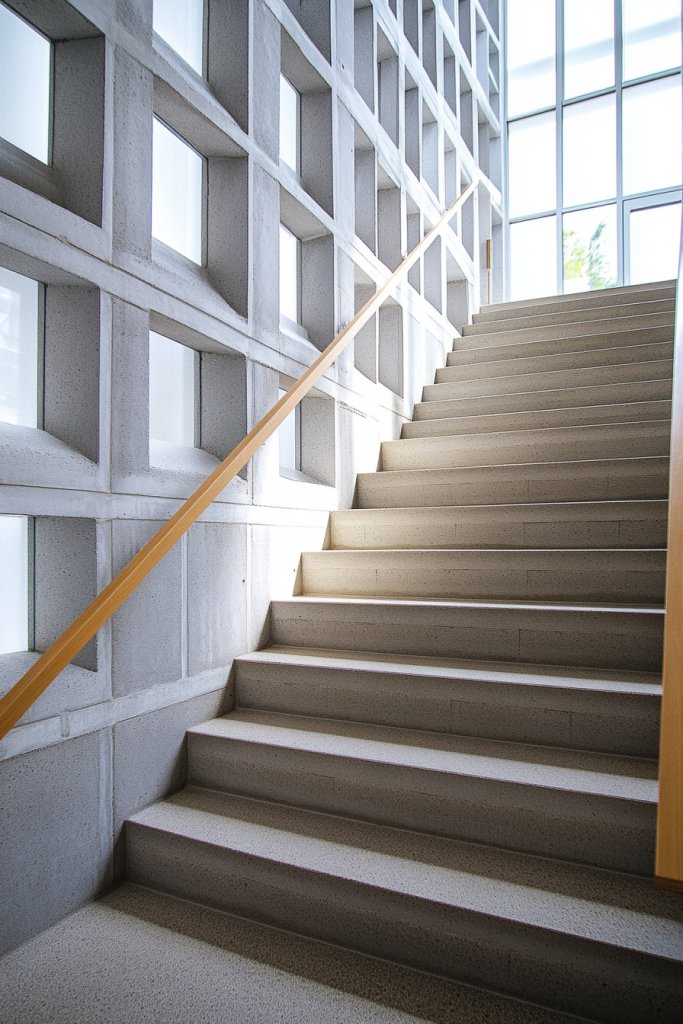
Want to make your staircase more interesting and less boring? A plain wall along your stairs can feel dull and uninspired. Using breeze blocks in the staircase wall adds texture and visual intrigue without overwhelming the space. It’s an easy way to elevate a functional feature into a design statement.
Envision a staircase wall where breeze blocks are arranged in a flowing pattern, creating a sense of movement. The open design allows light to pass through, making the stairs feel airy and less confined. When illuminated from the side, shadows dance along the steps, adding depth and drama. The textured pattern complements modern and industrial interiors, turning a simple feature into art.
Arrange the breeze blocks in a linear, spiral, or random pattern depending on your style. Use contrasting colors or finishes to emphasize the pattern. For outdoor stairs, choose weatherproof materials and finishes. Incorporate lighting along the handrail or beneath the steps to highlight the pattern at night. This concept suits both residential and commercial settings.
Measure the wall and plan your pattern layout carefully. Secure breeze blocks with mortar or anchors, ensuring they are level and aligned. Consider reinforcing the structure with a frame if needed for stability. Finish with paint, sealant, or protective coatings suitable for your environment. Add lighting fixtures or LED strips to enhance the pattern’s visibility and impact. Regular checks for stability and cleanliness are recommended.
Decorate with painted or textured breeze blocks to match your decor. Add small decorative elements like metallic accents or embedded lighting. Use contrasting grout or paint to make the pattern stand out more. Personalize with custom motifs or initials integrated into the pattern for a unique touch.
Incorporating breeze blocks into your staircase wall creates a stunning architectural feature that’s both functional and artistic. It adds personality and modern flair while maintaining openness. Perfect for contemporary homes, lofts, or commercial spaces wanting a stylish upgrade. Why not turn your staircase into a visual journey?
17. Creating a Dividing Wall in Open-Plan Kitchens and Living Rooms
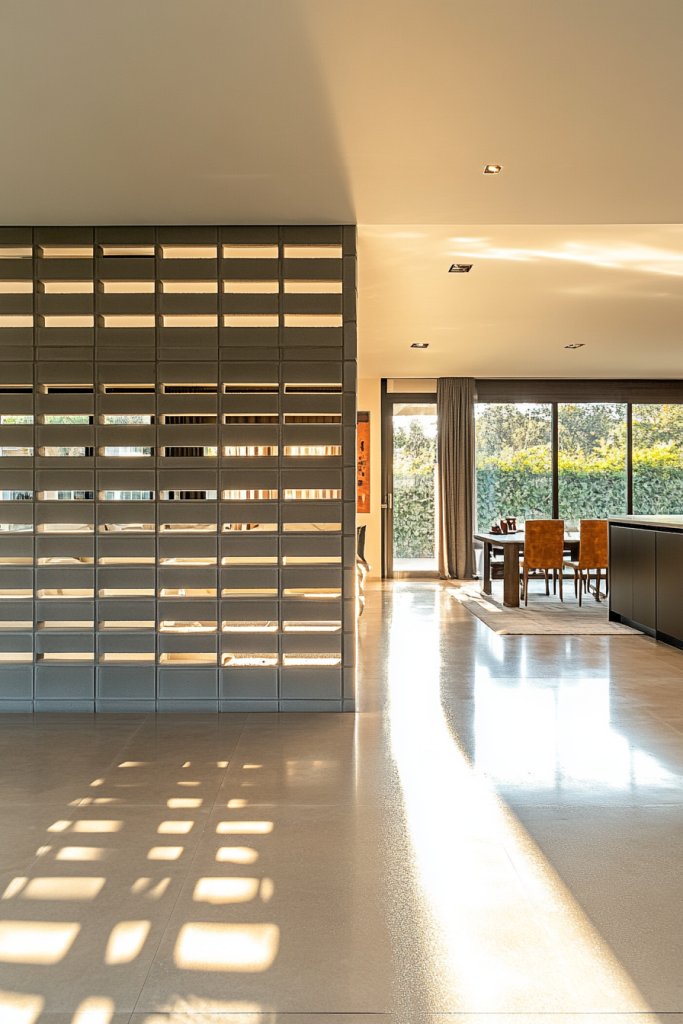
Living in an open-plan space can feel spacious but also chaotic. You might want to define zones without sacrificing the airy feel. Breeze block walls serve as stylish dividers that let light and air pass through, creating separation with a modern twist. It’s a clever way to organize your home without walls closing you in.
Visualize a breeze block partition separating your kitchen from the living area. The pattern allows partial views and airflow, maintaining a sense of openness. The textured pattern adds visual interest and complements contemporary decor. When illuminated from behind or the side, it casts delicate shadows, enhancing the zoning effect. This creates a functional yet aesthetic division that feels seamless.
Experiment with different pattern densities—tight or open—to control privacy. Use contrasting colors or finishes to match your overall decor. Incorporate integrated shelving or countertop extensions for added utility. For outdoor kitchens, select weather-resistant breeze blocks and finishes. Adjust height and pattern for different levels of separation.
Construct the partition with a stable frame or directly attach to existing walls. Secure breeze blocks with mortar or industrial adhesive, ensuring alignment. Finish with paint, sealant, or protective coating suited for indoor or outdoor use. Install lighting—LED strips or spotlights—to highlight the pattern and add ambiance. Check stability regularly and clean the surface to maintain appearance.
Add decorative elements like tiles or contrasting grout to emphasize the pattern. Include functional features such as hooks or small shelves integrated into the design. Use lighting creatively to enhance the division at night. Personalize with motifs or colors that reflect your style, creating a space that’s both functional and inspiring.
A breeze block dividing wall is a modern, stylish way to organize open spaces. It maintains openness while creating functional zones, making your home feel more structured and inviting. It’s a DIY-friendly project with impressive visual impact. Turn your open-plan into a curated experience that feels spacious and sophisticated.
18. Combining Breeze Blocks with Colored Accents for a Playful Touch
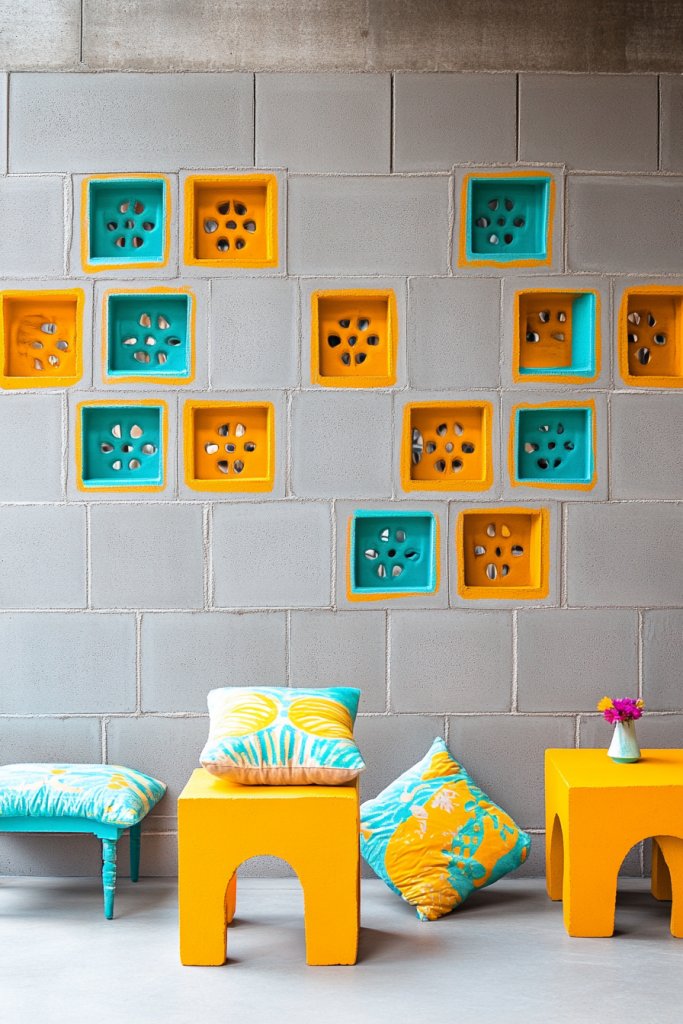
Feeling that your walls need a splash of fun? Bright colors and accents can transform a dull space into a lively, playful environment. Breeze blocks offer a perfect canvas for creative color combinations and accents. It’s a simple way to inject personality and cheer into your decor.
Imagine a breeze block wall painted in a neutral tone but with some blocks accented in vibrant hues—yellow, teal, or coral. The contrast creates a whimsical, eclectic look that draws the eye. When light passes through, the colored sections cast cheerful shadows and add depth. It’s like turning your wall into a colorful mosaic that energizes the room.
Play with color blocking or patterns—alternating colors, gradients, or random placements. Use contrasting grout or borders to frame the accents. Combine with playful decor like patterned textiles or quirky furniture. This approach works well in kids’ rooms, creative studios, or casual lounge areas. Adjust the intensity of colors to match your mood or season.
Paint the breeze blocks with weatherproof or indoor paint suitable for masonry. Use painter’s tape for clean edges and multiple coats for vibrant color. Consider masking some sections for a precise pattern or freehand for a more spontaneous look. Seal the paint with a clear protective coat for longevity. Regular touch-ups keep the colors fresh and lively.
Add decorative decals or small mosaic tiles in selected areas for extra flair. Incorporate themed motifs or initials for a personalized touch. Use colorful lighting—like RGB LED strips—to change the mood at night. Combine with bright textiles or accessories to complete the playful look. Make it a reflection of your personality.
Combining breeze blocks with colorful accents creates a lively, engaging environment that’s easy to achieve. It’s perfect for adding a personal touch without overhauling your entire decor. Playful, bold, and customizable—this idea makes your walls fun and functional. Ready to brighten your space with a splash of color?
19. Installing a Breeze Block Wall as a Garden Boundary
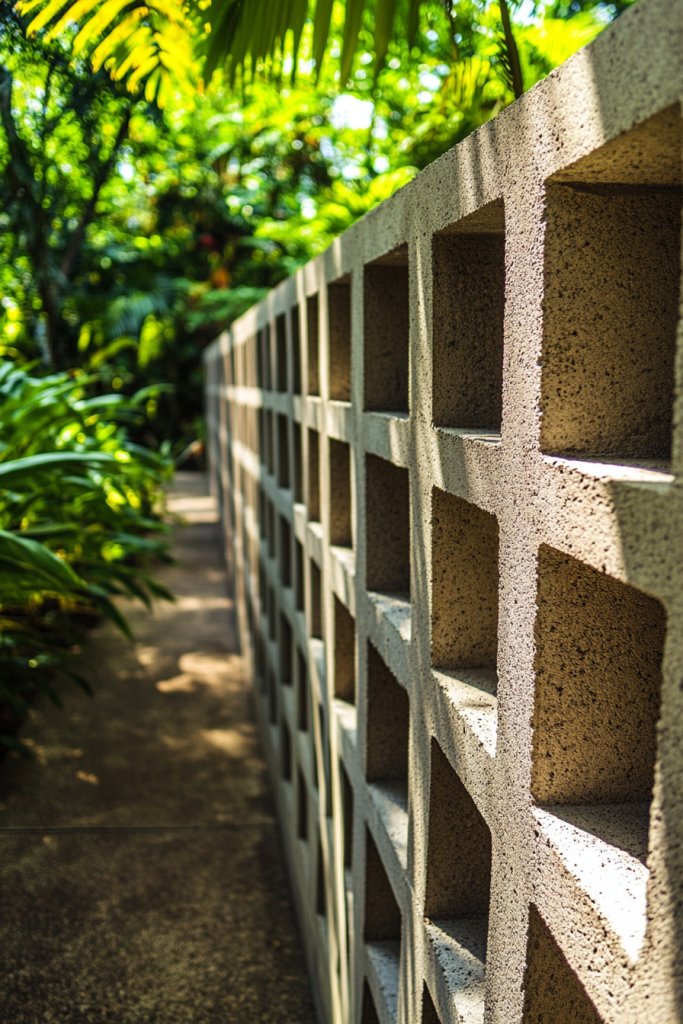
Looking to define your garden space without blocking views? A breeze block wall makes an attractive boundary that’s both functional and stylish. It offers privacy, security, and a modern touch, all while allowing light and air to flow freely. Perfect for creating a neat, organized outdoor area.
Envision a low breeze block wall delineating your garden perimeter, with some blocks painted in vibrant colors or left raw for a natural look. The open pattern allows glimpses of plants and flowers, creating a sense of openness. When complemented by lush greenery, the wall becomes a backdrop that enhances the natural beauty of your garden. The textured surface adds visual interest and complements organic forms.
Vary the height and pattern density for different degrees of privacy. Use weather-resistant breeze blocks and finishes for durability. Incorporate decorative caps or metal accents to add sophistication. For a more rustic look, leave some breeze blocks in their natural concrete state. It adapts well for garden borders, pathways, or even as a backdrop for outdoor seating areas.
Lay a strong foundation using concrete or compacted gravel. Secure breeze blocks with outdoor mortar or anchors designed for exterior use. Leave gaps for drainage and air circulation. Seal the surface with weatherproof sealers to prevent staining or deterioration. Consider adding decorative elements like metal inserts or painted sections for extra character. Regular maintenance involves cleaning and inspecting stability.
Decorate the top with stone caps or metal finials for a finished look. Incorporate climbing plants or hanging planters near the base for a lush effect. Use outdoor lighting to highlight the pattern at night. Personal touches like engraved stones or custom colors can make your boundary uniquely yours.
A breeze block garden boundary combines practicality with modern design, creating a stylish outdoor perimeter. It’s a durable, low-maintenance solution that enhances curb appeal. Perfect for contemporary gardens, patios, or eco-friendly landscapes, it’s an easy upgrade that makes your outdoor space feel complete. Why not define your garden with style?
Conclusion
With such a diverse range of breeze block wall ideas, there’s no limit to the stylish transformations you can achieve. Whether you want a striking feature wall or a functional divider, these concepts are easy to adapt to your space. Dive in, get creative, and turn your home into a stunning showcase of design ingenuity!

Leave a Reply